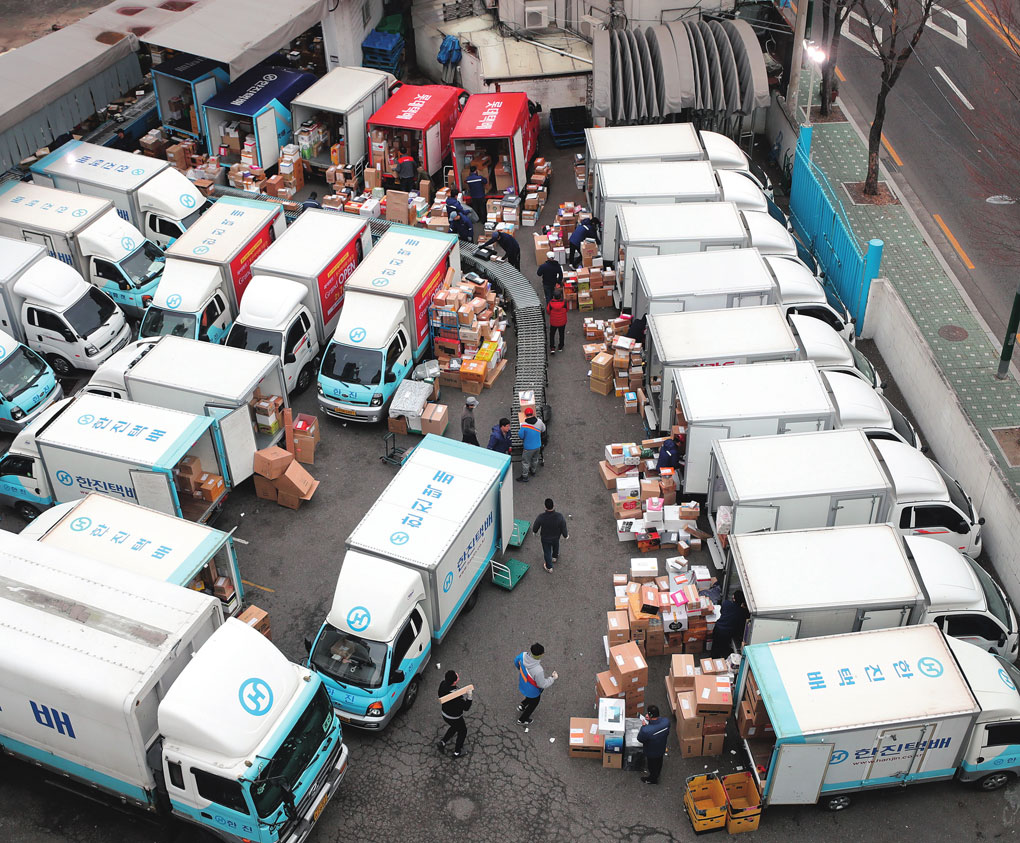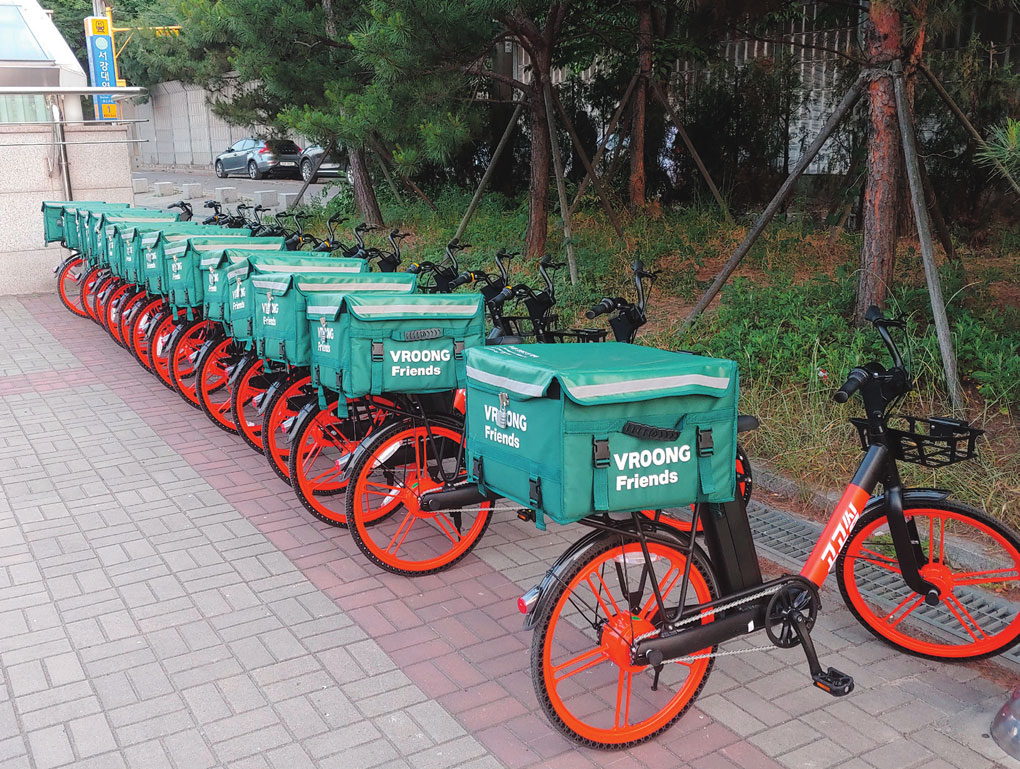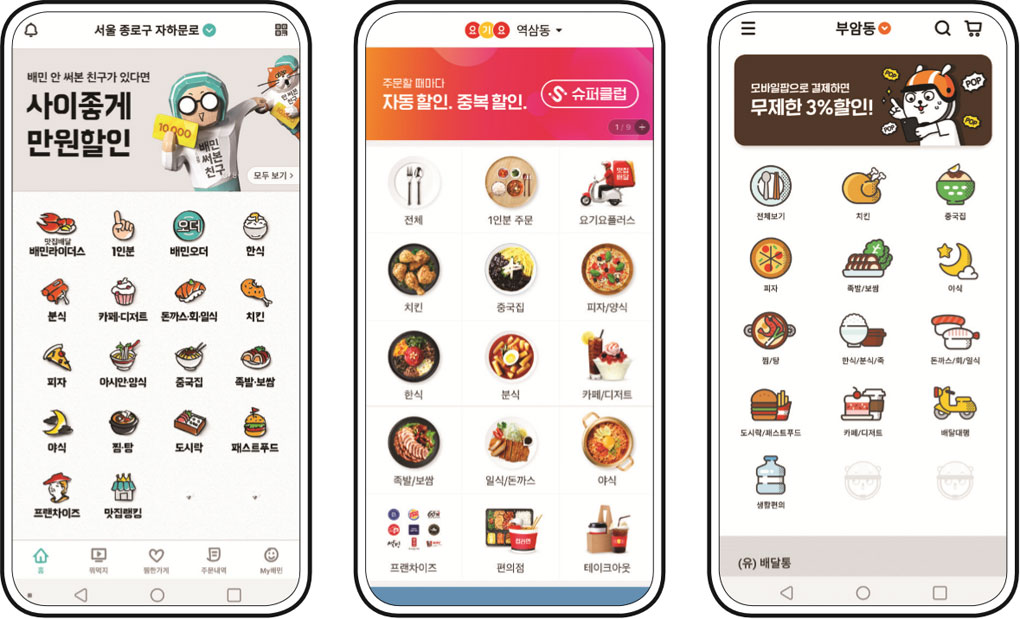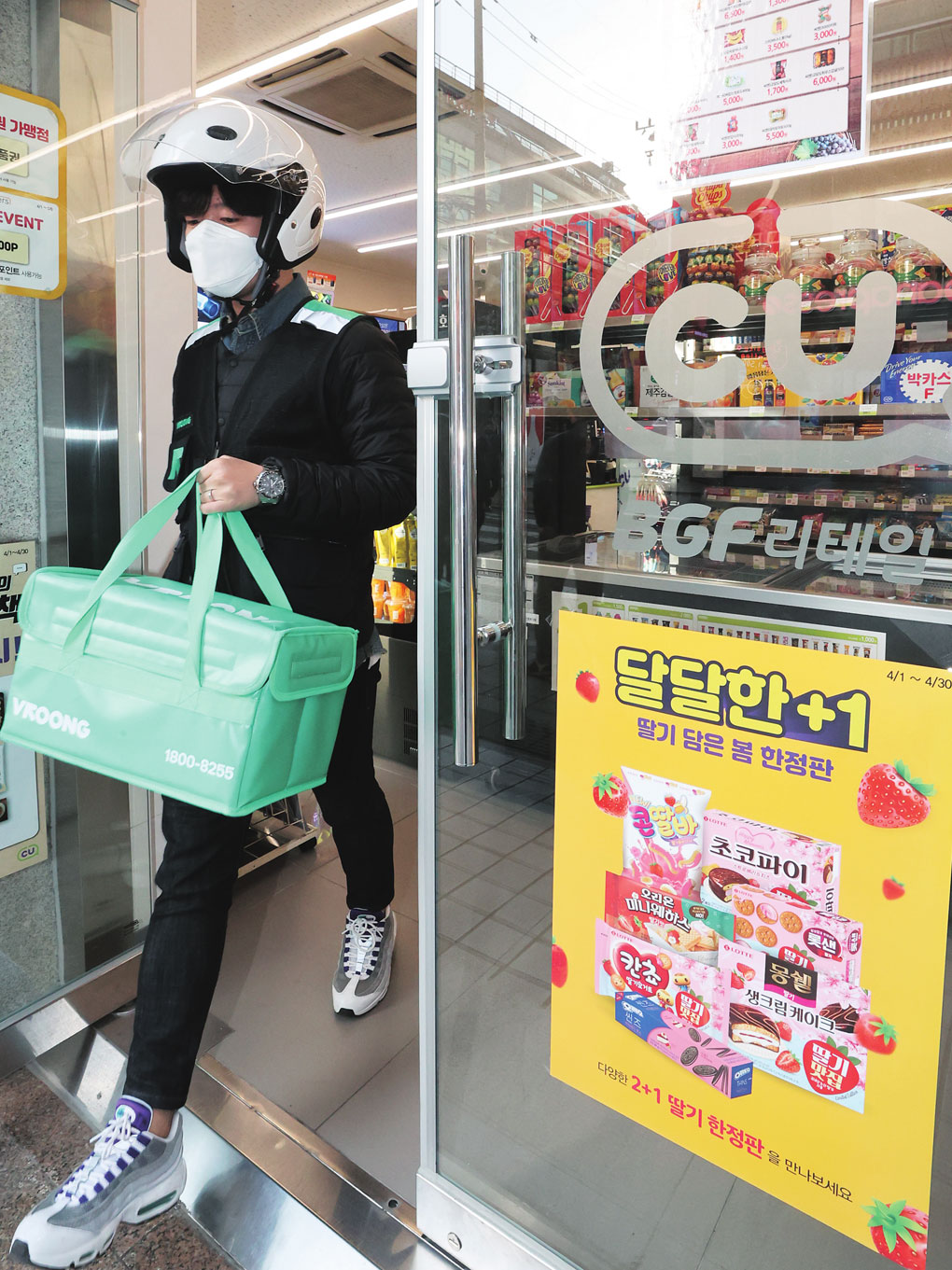The food delivery industry is thriving as the COVID-19 pandemic propels a shift to a contactless lifestyle. Mobile platforms, no longer mere tools for brokering food orders, have expanded delivery services to a wider range of items. While these platforms are rapidly evolving and prospering, the industry is tasked with addressing monopolization and labor conditions.
In 2018, Korea’s online shopping transaction volume topped the 100 trillion won mark for the first time, reaching 114 trillion won. That year, food delivery accounted for a mere 4.6 percent of the total. In the first half of this year, however, transactions for online food service exceeded 1 trillion won per month, according to Statistics Korea. The monthly total in April, for example, increased 83.7 percent year-on-year, occupying the third-largest share at 10.5 percent, coming just behind groceries and beverages at 12.7 percent, and home appliances, electronics and telecommunications equipment at 11.5 percent.
There is little doubt that the COVID-19 pandemic is a significant factor in these trends. Amid widespread social distancing, dining out has become less frequent while takeout or delivery is considered the “new normal.” According to Open Survey, a mobile data research company, almost 70 percent of consumers in their 40s and 50s surveyed said their reluctance to dine out during the outbreak made them turn to food delivery. Given this group’s previous tendency to stay away from food delivery, the change is noteworthy. Industry figures suggest that, having experienced the convenience of mobile delivery apps, these consumers will likely continue shopping online after the pandemic ends – not just for food but for other products as well.
Mobile app-based delivery platforms have been driving the growth of the domestic market since before the current health crisis. When Apple introduced the iPhone in 2007, delivery platforms found their opportunity in the mobile environment. Conventional telephone orders, based on information from flyers and brochures, swiftly gave way to the current method of processing every phase of an order via mobile apps. Delivery platforms developed profit models based on advertising (showcasing client stores on their app) or charging a commission per order.

As demand for non-contact delivery service spikes amid the COVID-19 outbreak, a delivery company’s distribution center in Seoul is crowded with parcels and workers sorting them by destination. The excessive workload and labor conditions of those in the delivery service industry have emerged as a new social issue. © Yonhap News Agency
Expansion of Services
A survey conducted by the Korean Foodservice Industry Association in March 2019 shows that 62.2 percent of all food delivery orders were received via mobile app versus 37.5 percent by telephone. Consumer surveys yielded similar results. Earlier this year, Open Survey’s research on 1,500 men and women aged 20 to 59 nationwide revealed that about 60 percent of respondents accessed food delivery services via specialized websites or smartphone apps.
Delivery platforms are trying to gain a competitive edge by offering different benefits to restaurants and consumers. Consumers obviously prefer simplified mobile pay options allowing one-stop prepayment for both food and delivery. In the current pandemic situation, the COD (cash/collect on delivery) method using cash or credit cards is quickly being replaced by simple online payment. Many consumers go even further, opting to have their food dropped off at their doorstep in order to avoid human contact.
Another prominent trend is the expansion of the range of items for delivery. The scope of services is widening beyond food delivery to include a great variety of commodities: processed food like snacks and ramen noodles; daily necessities such as bottled water, toilet paper and detergent; and refrigerated fresh food like groceries, meat and semi-cooked meal kits. In 2019, Woowa Brothers Corp., which operates Korea’s largest delivery app, Baedal Minjok (a.k.a. Baemin), launched B Mart, an instant grocery delivery service that deals with almost all products available in supermarkets. Delivery Hero Korea, owner of the second and third largest platforms, Yogiyo and Baedaltong, respectively, is also enlarging its list of service items in partnership with local convenience stores and supermarkets.
In addition, a growing number of delivery platforms are expanding services available to restaurants. They even provide food materials, packing containers and other subsidiary items, and develop POS (point of sale) systems for restaurant management.
Korea’s food delivery market has a duopoly structure. On one side is Woowa Brothers, a homegrown company that launched Baemin in June 2010, and on the other is Delivery Hero Korea, the Korea branch of Delivery Hero, a German-based multinational food delivery giant. After establishing Yogiyo in 2012, Delivery Hero Korea drastically raised its market share in 2014 by acquiring Baedaltong, which launched the world’s first click-to-call delivery application in April 2010.

Delivery bicycles for Vroong Friends are on standby near a subway station. Anyone who signs up as a part-time rider on the platform can use the bicycles to carry out deliveries. Delivery service providers, finding it hard to deal with the flood of orders with their full-time staff, started to recruit part-time riders. © Um Ji-yong
Monopoly and Competition
This duopoly is expected to collapse very soon. In December 2019, Delivery Hero Korea announced its plan to take over Woowa Brothers, heralding a tectonic shift in the domestic delivery industry. If the acquisition plan passes the M&A review by the Korea Fair Trade Commission, the combined firm will possess the industry’s three largest platforms and a market share of 99 percent. The prospective birth of a behemoth monopoly has stirred heated controversy. Affiliated stores worry about collusion resulting in unreasonable commissions and advertising costs, while consumers are wary of possible hikes in delivery fees.
Woowa Brothers was quick to explain that, despite their merger, the two companies would maintain independent management and competition, though this was insufficient to quell the controversy. As a countermeasure to prevent monopoly, some local governments have already launched, or are developing, public delivery apps for their respective regions. Moreover, Coupang Eats and WeMakePrice O have joined the competition, foreshadowing significant changes in the geography of the food delivery market.
Along with the impressive growth of delivery platforms, another notable phenomenon is the appearance of delivery providers. First-generation platforms, which functioned as brokers between restaurants and consumers, lacked their own delivery networks. Actual delivery was handled by restaurants, either by the owners themselves or the deliverymen they employed. Since orders were concentrated at lunch and dinner time or late-night hours, restaurants with their own delivery workers had to find ways to make the most of them during lulls in business, sending them to hand out flyers, for instance.
Delivery providers saw an opportunity in this niche, offering their services to restaurants for a monthly management fee of 100,000-150,000 won, plus a delivery fee of about 3,000 won per order. By outsourcing delivery, restaurants can reduce expenditures or losses incurred by employing their own delivery drivers. Back in 2013, when delivery startups began appearing, many restaurants used their services to complement their own workforce, but the number of restaurants relying solely on delivery providers has since risen gradually. Today, the three frontrunners in the market in terms of monthly orders are Saenggakdaero (10 million), Barogo (9.8 million) and Mesh Korea (4 million). None of them has made a net profit yet due to intense competition, but they are growing quickly.

Popular food delivery apps: from left, Baedal Minjok, Yogiyo and Baedaltong. Figures from mobile big data platform IGAWorks show that the number of Android OS users is the highest for Baedal Minjok (9,701,158), followed by Yogiyo (4,926,269), Coupang Eats (391,244) and Baedaltong (272,139). Baedaltong had consistently ranked third since its launch in 2010 but was overtaken by Coupang Eats in the first half of 2020.
On the other hand, there has been concern about the increase of platform-mediated labor because it s a class of workers whose rights are not guaranteed by law.
Under existing Korean laws, these independent contractors are classified as “workers in special types of employment,” with hardly any protections in case of work-related accidents or conflicts with their client companies.
Delivery Providers
The first-generation platform giants Woowa Brothers and Delivery Hero Korea also came to build their own delivery networks, launching Baemin Riders and Yogiyo Plus, respectively. Delivery Hero Korea went further to invest 20 billion won in Barogo, presumably a move to enhance its logistics capacity. This means Baemin and Yogiyo charge higher fees – 15-30 percent compared to 6-12 percent for older platforms – as they include delivery service charges. Coupang Eats (run by Korea’s largest online retailer Coupang), Ddingdong (operating in Seoul’s Gangnam area) and Foodfly (acquired by Yogiyo) are all examples of delivery providers that succeeded with this business model. Now, these second-generation delivery platforms equipped with their own logistics networks are entering the mainstream.
The emergence of second-generation delivery platforms has sparked social concerns regarding “platform-mediated labor.” This system involves a wider pool of independent contractors in addition to full-time delivery workers registered to each platform. Barogo’s Barogo Flex, Mesh Korea’s Vroong Friends and Woowa Brothers’ Baemin Connect are major examples of this system. Coupang Eats hired independent contractors from the beginning because it struggled to process rush orders with its own network, getting complaints for late or missed deliveries.
To cover time slots with high demand in metropolitan areas where orders are clustered, major delivery providers recruit independent contractors through crowdsourcing. The companies emphasize that contractors can choose to work as much as, and whenever, they want. They earn 3,500 to 4,000 won per delivery, whereas full-time delivery workers make 3,000 won per delivery. This recruitment plan has met with a favorable response. According to Woowa Brothers, a total of 14,730 independent contractors had signed up for Baemin Connect as of February 2020. This makes their pool seven times larger than the 2,300-person network of Baemin Riders.

A rider for Vroong Friends leaves a convenience store in Seoul after picking up an order. As demand for delivery surges, convenience store products have been included on the ever-expanding list of delivery items. This store has extended its delivery hours to 24/7 from 11 a.m. to 11 p.m. © NewsBank
Platform Workers
On the other hand, there has been concern about the increase of platform-mediated labor because it s a class of workers whose rights are not guaranteed by law. Under existing Korean laws, these independent contractors are classified as “workers in special types of employment,” with hardly any protections in case of work-related accidents or conflicts with their client companies. They cannot benefit from social insurance schemes or paid holidays stipulated by labor laws. When demand for delivery services skyrocketed with the outbreak of the coronavirus pandemic, the inferior working conditions of these contractors were laid bare once again, with their basic rights spotlighted as a social issue. There is now a growing voice over the urgency of systemic improvement to protect the rights of this new class of workers.
Um Ji-yongReporter, Byline Network